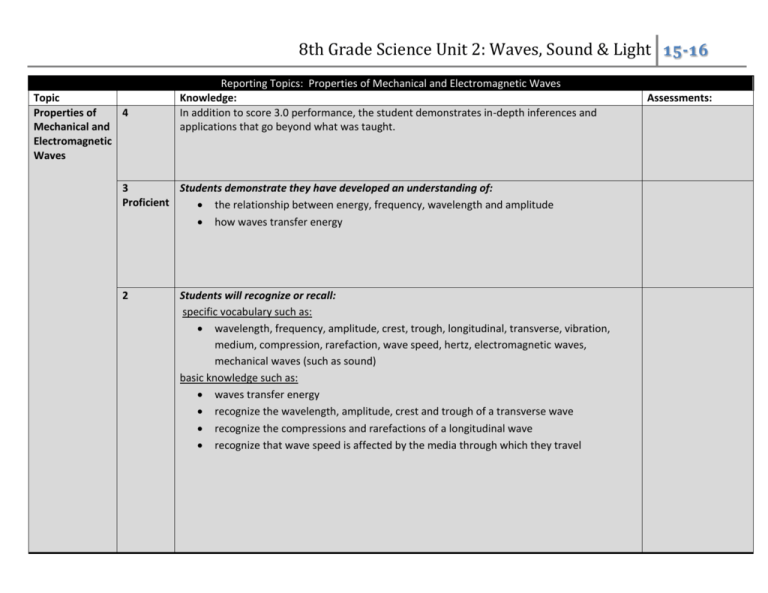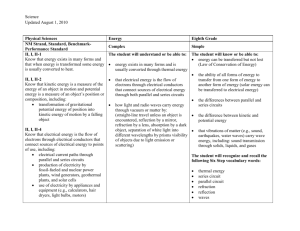8th Grade Science Unit 2: Waves, Sound & Light
advertisement

8th Grade Science Unit 2: Waves, Sound & Light 15-16 Topic Properties of 4 Mechanical and Electromagnetic Waves Reporting Topics: Properties of Mechanical and Electromagnetic Waves Knowledge: In addition to score 3.0 performance, the student demonstrates in-depth inferences and applications that go beyond what was taught. 3 Students demonstrate they have developed an understanding of: Proficient the relationship between energy, frequency, wavelength and amplitude how waves transfer energy 2 Students will recognize or recall: specific vocabulary such as: wavelength, frequency, amplitude, crest, trough, longitudinal, transverse, vibration, medium, compression, rarefaction, wave speed, hertz, electromagnetic waves, mechanical waves (such as sound) basic knowledge such as: waves transfer energy recognize the wavelength, amplitude, crest and trough of a transverse wave recognize the compressions and rarefactions of a longitudinal wave recognize that wave speed is affected by the media through which they travel Assessments: 8th Grade Science Unit 2: Waves, Sound & Light 15-16 Interactions of Waves 4 Reporting Topics: Interactions of Waves In addition to score 3.0 performance, the student demonstrates in-depth inferences and applications that go beyond what was taught. 3 Students demonstrate they have developed an understanding of: Proficient the various wave interactions and are able to discuss examples of each (transmission, absorption, reflection, refraction, diffraction, scattering and interference) o how the color of an object is perceived (transmission and reflection) the relationship between visible light wavelength and frequency (how color of light is determined) differences among the wavelengths and frequencies of the electromagnetic spectrum 2 Students will recognize or recall: specific vocabulary such as: transmission, absorption, reflection, refraction, interference, scattering, transparent, translucent, opaque, diffraction, electromagnetic spectrum basic knowledge such as: the difference among transparent, translucent and opaque the ranges of the electromagnetic spectrum (radio waves to gamma waves) the visible spectrum 8th Grade Science Unit 2: Waves, Sound & Light 15-16 Suggested Instructional Resources Learner Objectives Topic Textbook Resources Labs PBL Ideas (projects) Web Resources – websites or resources on http://science.dmschools.org I can distinguish between types of waves. Properties of Mechanical and Electromagnetic Waves I can describe the characteristics of waves. I can compare and contrast sound and light waves. I can compare and contrast transmission, absorption, reflection, refraction and scattering of waves. I can explain how the color of an object is determined. I can trace the route light must take in order to be seen and the role the eye plays in vision. Interactions of Waves







